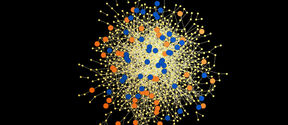Department of Computer Science
cs.aalto.fi

Human interaction is profoundly shaped by our social networks, which extend their impact to both offline and online domains. A new study by network scientists at Tampere University, Aalto University and the Central European University investigated how our social circles are formed and maintained in various communication channels.
The authors examined how people stay connected by analysing metadata on 1.9 billion calls and messages, alongside millions of tech-mediated social interactions, which included anonymized calls, messages, work-related emails, texts, and even messages on dating platforms. The study revealed that people tend to nurture social bonds in consistent ways regardless of their communication method.
‘The most striking aspect of our findings is that people form similar-looking social networks with their friends and family as well as with complete strangers on the Internet,’ says Jari Saramäki, professor at Aalto University’s Department of Computer Science. ‘This is unintuitive, because these channels have very different roles – you wouldn’t think that the way you use your phone to call friends and family resembles the way you engage with people on online forums. In all the 16 channels we studied, most people cherish a few close relationships while investing little time for the rest.’
Previous studies, while hinting at these patterns, have not undertaken a comprehensive exploration of their universal applicability and the mechanisms at play.
‘By using a mathematical model, we can attribute these findings to competition between two forces: reinforcing familiar, strong ties that therefore get stronger, and communicating with anyone regardless of the strength of the relationship,’ says Saramäki. ‘We can observe these mechanisms at play in all channels, albeit for presumably different reasons – I reach out to my close friends because they’re my close friends, but on an online forum I engage with a few people time and again for another reason, perhaps because it is easiest.’
Yet, within the general tendency to invest in a few relationships, the research team also found individual differences: some like to focus more on their strongest ties, some like to explore more. This finding was novel, as it was previously only found in mobile phone data.
‘The shape of our social signatures appears to be stable in time, even when people in our social networks change,’ says Gerardo Iñiguez, associate professor at Tampere University. ‘Almost as if this was a behavioural trait that we take with us wherever we go, be it a corporate intranet or an online forum for metal fans.’
The research article can advance our understanding of how social networks function and support a more meaningful social life.
‘Having diverse social relationships correlates with increased longevity, better cognition while aging, and resilience to disease. It then seems crucial to figure out why people shape their social circles the way they do. This might help to facilitate social interactions that improve their health,’ says Sara Heydari, doctoral researcher at Aalto.
The study was recently published in Nature Communications.
Reference: Gerardo Iñiguez, Sara Heydari, János Kertész & Jari Saramäki (2023). Universal patterns in egocentric communication networks. Nature Communications. doi: https://doi.org/10.1038/s41467-023-40888-5

cs.aalto.fi

Data and traces of our mobile phone use and digital behaviour can be used to understand and treat mental health disorders.

Complex systems are found at all scales in nature, from the complex machinery operating inside our cells to the human brain, from human sociality to the networked social organization.



